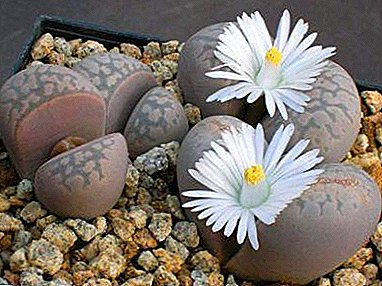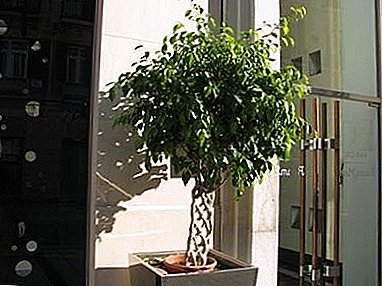
Lithops are very beautiful succulents that inhabit the rocky African deserts. Their name translates as "living stones". There are about 30 species and 60 subspecies.
Unusual exterior color and resistance to various natural conditions attracts attention to plant growers from around the world. A simple care makes it possible to grow a flower at home.
You can find out more about the proper care and maintenance of such unusual succulents as “living stones” and the difficulties that an amateur grower may encounter in our article.
Bloom
Lithops are interesting plants that come from the succulent genus and belong to the family of the Aizas. They do not have a stem and, by external signs, are similar to stones of small size, round shape and different color.
Succulents have fleshy, thick leaves that are connected in pairs and are separated by a deep hollow. The maximum height can be up to 10 cm.
When does lithops flower at home? The plant begins to bloom only in the third year after planting.from late summer to November. Only some individuals bloom, and the rest gradually join each year. Inflorescence appears between the leaves, usually yellow or white flowers. And the bud opens for several hours a day and can close the entire succulent. Flowers have a large number of sepals and petals.
Hold buds 7-12 days. In the case of pollination at the end of flowering appears a box with seeds.
Important! For normal life Lithops require peace. In the period of hibernation occurs the process of molting - the replacement of old leaves with new ones. At this time, you need to completely stop watering and put the plant pot in a cool, bright place and leave it alone.
The optimum temperature is 12-16 degrees. Shedding ends in March - April. This treatment is required only for adult succulents. Young seedlings up to a year need constant watering and additional lighting.
Succulent Photos
Below is a photo of the plant.





Care and maintenance of flowers in the house
How to properly care for these amazing "live stones"? Lithops unpretentious and easy to maintain. And care for them will not be difficult even for novice flower growers. It is enough to study their needs and create a comfortable environment.
Lighting
Lithops are very light-loving plants. In the first half of the day they need 4-5 hours of direct sunlight, and partial shade in the second half. In the period when the brightness of the sun decreases, the flowers open.
In winter, lithops require additional lighting. Well suited for this fluorescent or LED lamps. If they are not installed, then without light, the plants are drawn out, begin to lose weight, and may die. Place the lamp at a distance of not more than 10 cm from the flowers, and seedlings at a distance of 5-8 cm.
Temperature
In the summer period, succulents can be contained at a temperature of from 20 to 25 ° C, but the plant tolerates higher temperatures as well. And also at this time they can be taken out on the balcony or in the garden, while in the daytime it is recommended to shade the plant. Being outdoors hardens and makes them stronger, which contributes to flowering.
In winter, the Lithops need a cold wintering. The optimum temperature for them in the cold period is 8-12 ° C. At higher temperatures, the plant is strongly drawn out, loses its appearance and ceases to bloom.
Location
Due to the fact that lithops fans of sunlight, it is best to keep them on the south window or balcony. And as close as possible to the glass.
Do not rotate the position of the pot relative to the light source. Therefore, when carrying out to the loggia, it is necessary to make a mark so that in the new place the sun's rays fall from the same side as before.
How to water?
 When caring for plants, special attention should be paid to watering. A large amount of water will destroy it very quickly. From April to September, the succulents are watered moderately, not more often than once in 11-15 days. During this period of time, an intense growth and flowering occurs in the Lithops.
When caring for plants, special attention should be paid to watering. A large amount of water will destroy it very quickly. From April to September, the succulents are watered moderately, not more often than once in 11-15 days. During this period of time, an intense growth and flowering occurs in the Lithops.
From October to December, watering is reduced to once per 24-30 days. The rest of the time it is strictly prohibited. With the appearance of tying buds, usually in early July, watering is canceled until the flowers are fully bloomed. And then proceeds according to the old scheme. If during flowering the soil does not dry out, the interval between watering increases.
A syringe or a watering can with a narrow and long nose is used for the procedure, since moisture in the gap between the leaves is strictly not allowed.
Attention! Pouring water into the pan is also not recommended. Water should be defended and not hard. For tap water for every 10 liters, add 0.5 g of citric acid.
Air humidity
Lithops do not require special conditions of relative humidity. They easily tolerate a long stay in a room with dry air. The main thing is to regularly air the room where there is a pot with a flower. But at the same time it is necessary to ensure that there is no drafts, since this can adversely affect the plant.
On particularly hot days, it is recommended to spray the air around the plant from a small dispenser. You can not keep Lithops next to the moisture-loving flowers.
Top dressing
Due to the fact that lithops are very hardy plants, they do not require constant fertilization. However, if they have not been transplanted for a long time and have been growing in a small pot, then the ground has been very exhausted during this time and top dressing will only be useful. Carry out the procedure 1-2 times a year.
Mainly liquid fertilizers are used for cacti, the most popular of which are Zdrav'in, Aetisso, Life Force, etc. Concentration must be made two times less than what is written on the package. Dilute fertilizer with water and apply after watering. It is not recommended to conduct top dressing in late autumn and during wintering.
The soil
The composition of the soil for Lithops can be practically any, it should not contain limestone and in a high concentration of minerals. The soil must hold the required amount of water, and was nutritious.
Plant substrate can be purchased at a flower shop. But it is better to cook yourself for this 1 part of soddy humus, clay and brick chips to mix with 1.5 parts of quartz sand.
The bottom of the pot is tightly laid with gravel to provide ventilation and outflow of excess water. And after planting the lithops, the top layer of soil is covered with pebbles or prickly shells to prevent evaporation of moisture and the development of moss.
Do I need to trim?
The plant does not require pruning and molding, it is better not to touch it. Even dried leaves should not be cut off, as this can cause damage to the flower's neck and death.
Breeding types
Lithops breed in two ways.
Seeds
 After flowering, a fruit with seeds appears on the Lithops, it is removed and set aside until early spring, when they begin to germinate.
After flowering, a fruit with seeds appears on the Lithops, it is removed and set aside until early spring, when they begin to germinate.
- Before sowing, seeds are soaked for six hours in warm water.
- Meanwhile, the prepared soil is poured over with hot water.
- After the seeds are placed in the ground without deepening. The pot is covered with foil and set in a lighted place.
- Daily capacity of the seeds need to be ventilated for no more than 10 minutes and watered. As soon as the seedlings grow, increase the ventilation time up to 4 times a day and reduce watering. The film can be removed after 2-3 weeks, but you need to do this gradually, so that the seedlings have time to adapt.
- Replant them in separate pots after a year.
Read more about growing Lithops from seeds in this article.
From the video you will learn how to plant seeds Lithops:
Layering
Neatly divide the two leaves and sit in pots at a certain distance from each other. Before planting in the ground you need to level the root system of the plants so that it does not curl.
Transfer
Acquire Lithops is recommended only during the vegetative period. After purchase, they should be immediately transplanted into suitable soil.
Before planting, the root system is freed from peat, dried and checked for damage. Prerequisite is the presence of a drainage layer at the bottom of the pot. Then just lay the soil, pour over boiling water, carry the flower and watered. The pot should be no more than 10 cm.
Lithops do not need frequent transplantation. Adult plants are transplanted every 3-4 years, and young every 2 years. Carry out the process after wintering. The pot should be 1 cm above the previous one or can be moved to an old pot with new soil. All the subtleties and nuances of planting and transplanting this original plant can be found in a separate article.
Content difficulties
The main problems in the care of the plant:
- Due to excessive watering, plants suffer from stagnant moisture and rot of roots. Therefore, you need to control the amount of water applied.
- With frequent but moderate watering due to an overabundance of moisture, the succulents may burst. In this case, you should water them much less frequently.
- If the leaves are sluggish and shriveled, the Lithops do not have enough water. It is necessary to water, and the next day it will be brilliant.
- There is no flowering, the plant does not have enough light, overfed or too young.
- Sometimes mealybugs can appear on succulents. In order to get rid of them, the leaves of the plant are wiped with a soap solution. Some flower growers cover the pot with a flower package, and sprinkle a little dichlorvos inside and leave for 20-30 minutes, this procedure does not harm the plant. With a strong infection, you can use a variety of insecticidal drugs.
Conclusion
If Lithops appeared in the dwelling, do not be afraid of the difficulties, since care and cultivation does not cause any particular difficulties. The main thing is to follow all the rules and conditions of detention. And then the succulents with their beauty will please their master all year round.












